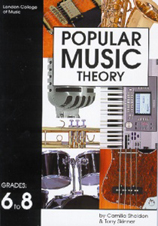
Popular Music Theory

Popular Music Theory
Candidates are expected to have a good knowledge of the notes that make up scales - this is essential if the scales learnt in theory are to be used in a practical context.
All scales and key signatures are fully illustrated and explained in the grade handbooks - which also contain sample questions and answers. Find out more
Scales for Grade 8 Exam:
All requirements from all previous grades, plus in all keys:
Candidates are expected to have a good knowledge of chord symbols and the notes that make up chords - this is essential if the chords learnt in theory are to be used in a practical context.
All chords are fully illustrated and explained in the grade handbooks - which also contain sample questions and answers. Find out more
Chords for Grade 8 Exam:
All requirements from all previous grades, plus in all keys:
Candidates should have a practical understanding of time signatures, as well as note and rest values (including correct grouping).
Illustrations and explanations of all relevant aspects of rhythm notation are shown in the grade handbooks - which also contain sample questions and answers. Find out more
Rhythm Notation for Grade 8 Exam:
As for previous grades, but of greater complexity, plus:
Candidates will be asked questions in three areas:
Further information on all aspects of this section of the examination is given in the grade handbooks - which also contain sample questions and answers. Find out more
Knowledge of Popular Music for Grade 8 Exam:
Questions in this section largely focus on the candidate's ability to relate the knowledge of scales and chords, from Sections 1 and 2, to practical music-making situations - such as improvisation and composition of chord progressions.
Further information on all aspects of this section of the examination is given in the grade handbooks - which also contain sample questions and answers. Find out more
Harmony for Grade 8 Exam:
In this section candidates will be asked to transpose, or identify transposed, chord progressions and melodies.
Further information on all aspects of this section of the examination is given in the grade handbooks - which also contain sample questions and answers. Find out more
Transposition for Grade 8 Exam:
Practising with past exam papers can provide ideal preparation for your exam. Past papers also provide you with a clear example of the type and format of questions that may appear in the exam.
Click here to purchase Grade 8 Exam Papers.
The seventh book the highly regarded 7 part series of Popular Music Theory handbooks and contains grades 6-8. This book is perfect for advanced students of popular music theory and will help you to gain deeper insight, improving your musicianship whether or not you intend to take the LCM examination.
All topics are for the exam are covered in a way that is directly applies to the music you play, making music theory both relevant and practical.
You’ll further develop your knowledge of keys, chords, scales, rhythms, harmony and improvisation as well as expanding your musical knowledge (including instrumentation, musical terms and the history of popular music).
